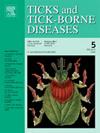一项使用纳米孔测序的全长16S调查,揭示了来自英国单一林地的蓖麻蜱的细菌微生物组,收集时间为2019-2021年的三个春季。
IF 3.4
2区 医学
Q2 INFECTIOUS DISEASES
引用次数: 0
摘要
蓖麻粘菌是几种细菌病原体的主要媒介,包括伯氏疏螺旋体和立克次体。为了评估细菌的流行率和多样性,我们对从英国单一林地收集的蜱虫的微生物组进行了表征,比较了不同的林地类型、生命阶段(成年雄性、雌性和蛹)和采样年份(2019-2021年春季)。与以往的研究不同,我们的研究目标是16S rRNA基因的短区域,我们使用纳米孔测序来生成全长16S reads,从而实现更高的分类分辨率。我们的研究结果表明,微生物组在不同的生命阶段存在显著差异,但在林地类型或年份之间没有差异。立克次体是最丰富的分类群,其流行率随生命阶段和年份的变化而变化。伯氏疏螺旋体存在于所有生命阶段,但在2021年的样本中不存在。无原体丰度在不同的年份和生命阶段差异显著,在松林若虫中最高。巴尔通体在所有林地类型中均有发现,以橡树为主地区若虫的丰度最高。本文章由计算机程序翻译,如有差异,请以英文原文为准。
A full-length 16S survey using Nanopore sequencing to uncover the bacterial microbiome in Ixodes ricinus ticks from a single UK woodland, collected across three springs (2019-2021)
Ixodes ricinus is a key vector of several bacterial pathogens, including Borrelia and Rickettsia species. To assess bacterial prevalence and diversity, we characterised the microbiome of ticks collected from a single UK woodland, comparing different woodland types, life stages (adult male, female, and nymph), and sampling years (spring 2019–2021). Unlike previous studies that target short regions of the 16S rRNA gene, we used Nanopore sequencing to generate full-length 16S reads, allowing for higher taxonomic resolution. Our results showed significant microbiome differences across life stages, but not by woodland type or year. Rickettsia was the most abundant taxon, with prevalence varying by life stage and year. Borrelia was present in all life stages but absent in 2021 samples. Anaplasma abundance varied significantly by year and life stage, peaking in nymphs from Pine woodland. Bartonella was found across all woodland types, with the highest abundance in nymphs from Oak-dominated areas.
求助全文
通过发布文献求助,成功后即可免费获取论文全文。
去求助
来源期刊

Ticks and Tick-borne Diseases
INFECTIOUS DISEASES-MICROBIOLOGY
CiteScore
6.90
自引率
12.50%
发文量
185
审稿时长
6-12 weeks
期刊介绍:
Ticks and Tick-borne Diseases is an international, peer-reviewed scientific journal. It publishes original research papers, short communications, state-of-the-art mini-reviews, letters to the editor, clinical-case studies, announcements of pertinent international meetings, and editorials.
The journal covers a broad spectrum and brings together various disciplines, for example, zoology, microbiology, molecular biology, genetics, mathematical modelling, veterinary and human medicine. Multidisciplinary approaches and the use of conventional and novel methods/methodologies (in the field and in the laboratory) are crucial for deeper understanding of the natural processes and human behaviour/activities that result in human or animal diseases and in economic effects of ticks and tick-borne pathogens. Such understanding is essential for management of tick populations and tick-borne diseases in an effective and environmentally acceptable manner.
 求助内容:
求助内容: 应助结果提醒方式:
应助结果提醒方式:


